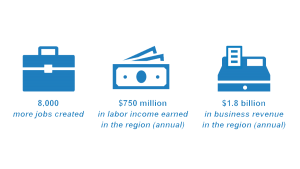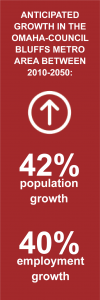Transit yields a Return on Investment: ROI Study Released
MAPA embarked on a Transit Return on Investment (ROI) Study to evaluate the “business case” for expanding regional transit. This study is built on established studies, The Heartland 2050 Vision and the Close the Gap Analysis of Potential Transportation Corridors in the Omaha-Council Bluffs Metro Area. This study’s goal is to provide a framework to support better transit, better futures, and smarter growth over time in the context of an evolving economy and land use.
Heartland 2050 is MAPA’s community-driven, big-picture vision for the Omaha-Council Bluffs metro area. In October 2017, a 28-member team representing business, government and philanthropy visited the Twin Cities of Minneapolis/St. Paul Minnesota as part of the Heartland 2050 initiative to experience the benefits of vibrant transit investments and best practices in private/public partnerships.
Inspired by the Itasca Project’s 2013 report, Regional Transit System: Return on Investment Assessment, Heartland 2050 secured funding from the public and private sector to hire a consultant and conduct a Return on Transit investment analysis.
The report covers four elements:
- The role of transit in connecting people to jobs and businesses to their workforce
- How future transit and land development can both shape the Omaha region as it manages significant anticipated growth
- How transit fits into an evolving mobility landscape of changing technologies
- Finally how results from the economic analysis of returns from strategic transit investments are coupled with supportive land use.
The analysis and content of this report were developed by EBP, in association with JEO Consulting Group, Inc. and Metro Analytics. MAPA oversaw the project and provided key staff support. The Greater Omaha Chamber also provided invaluable guidance to the study process.
The role of transit in providing workforce access allows for a connected landscape while providing equitable employment access; this is most important in service sector industries such as hospitality, retail, education, and health.
Connecting Omaha’s regional residents to employers, such as these plays an important role in activating strategic priorities.
Transit provides choices to support a quality of life, which is a game changer that uses talent attraction and retention tools for those seeking that talent in a way that is increasingly important to workers and employers, both in the Omaha region and nationally.
An average of 2,634 workers in the Omaha-Council Bluffs Metro Area rely on the services of Metro Transit to get to work each day. The Omaha region transit enables 689,000 trips per year by people who would not otherwise travel. Ninety-seven percent of those trips are made by people who did not have a car available for use – mobility freedom is indicative of the critical role played by transit in supporting equity of access and economic participation.
Heartland 2050’s central challenge is planning for Omaha’s regional growth while accommodating it in a manner that is sustainable and continues to deliver economic prosperity while improving the quality of life for its people.
Enhanced transportation options create a more vibrant and connected landscape. The Omaha region is posed to add nearly 400,000 people between 2010 and 2050. This growth can either be accommodated according to current trends of sprawling land use and auto-dominated development, or it can be supported by better transit and smarter growth.
Better transit, smarter growth is characterized by better, more comprehensive transit services oriented around key transit corridors building on the goals established by Heartland 2050 and other strategic initiatives in the region. Under this vision the region would invest in BRT (bus rapid transit) along with two additional corridors beyond the Omaha Rapid Bus Transit (ORBT) under construction.
Enhanced BRT service would significantly increase the coverage and quality of regional transit service. The Omaha region could achieve an increase in 20,000 trips made regionally each day by BRT, relative to the business-as-usual scenario.
Mobility services and new technologies are changing, allowing for emerging preferences. Various ride-hailing, ridesharing, car-sharing, bike-sharing and scooter-sharing companies have expanded mobility options beyond just bus transit services. New forms of transportation attract some users from other existing options.
The future can become even more complicated as autonomous vehicles become available to support even more variants of transit and ride share services, including “micro transit.” Seamless integration of transit and mobility services optimize people’s emerging preferences for mobility freedom.
The optimization from both cost and service viewpoints is clearly to have high performance, high frequency transit servicing major travel corridors, while other mobility services provide feeder service as well as more dispersed rides for lower volume areas and times. Along with seamless integration transit, scheduling and payments coordinated via phone app, in the future people can expect more flexible, multi-faceted transit options.
Greater investments yield greater benefits, providing better transit and achieving smarter growth in greater Omaha that will support regional economic growth. Economic development impacts result primarily from a more efficient transportation network, which reduces time and money spent on transportation, and connects workers to businesses better.
Enhanced transit equals less congestion, shorter travel times, more reliable trips and reduction of travel costs that will benefit people in the Omaha region in a number of ways.  If the Omaha region chooses to invest in an enhanced BRT network and succeeds in encouraging development along designated transit corridors over time, the regional economy can add as many as 8,000 jobs and see an economic impact of $1.8 billion in added annual business revenue by 2050.
If the Omaha region chooses to invest in an enhanced BRT network and succeeds in encouraging development along designated transit corridors over time, the regional economy can add as many as 8,000 jobs and see an economic impact of $1.8 billion in added annual business revenue by 2050.

